“Verliere ich meine Google-Rankings, wenn ich meinen Blog umziehe?” Das ist die häufigste Frage, die wir hören, wenn jemand über einen Wechsel von Blogger zu WordPress nachdenkt.
Wir verstehen das – aber nachdem wir unzähligen Bloggern bei dieser Umstellung geholfen haben, können wir Ihnen mit gutem Gewissen sagen: Es ist absolut möglich, von Blogger zu WordPress zu wechseln, ohne Ihre Google-Rankings zu opfern.
Im Laufe der Jahre haben wir den Migrationsprozess verfeinert, um Ihre SEO zu schützen, während Sie auf eine leistungsfähigere Blogging-Plattform upgraden. Durch Versuch und Irrtum haben wir genau herausgefunden, was Sie tun müssen (und was Sie vermeiden sollten!), um Ihren hart verdienten Platz in den Suchergebnissen von Google zu schützen.
In diesem Leitfaden führen wir Sie durch unsere bewährte Methode für den Wechsel von Blogger zu WordPress. Sie werden genau die gleichen Techniken lernen, mit denen wir unzähligen Bloggern wie Ihnen geholfen haben, ihre Websites zu upgraden, ohne ihre Sichtbarkeit in den Suchmaschinen zu beeinträchtigen.

Warum von Blogger zu WordPress wechseln?
Sie verwenden derzeit Blogger, eine beliebte, von Google erstellte Blogging-Plattform, mit der jeder mit seinem Google Konto einen kostenlosen Blog erstellen kann.
Für viele ist es ein großartiger Ausgangspunkt, aber viele Anfänger stellen schnell fest, dass ihr kostenloser Blogger-Blog sich ein wenig begrenzt anfühlen kann. Vielleicht wünschen Sie sich, Sie könnten mehr tun.
Genau hier kommt WordPress ins Spiel. Im Gegensatz zu Blogger haben Sie mit WordPress.org die vollständige Kontrolle über Ihre Website. Außerdem können Sie die notwendigen Funktionen hinzufügen, um Ihren Blog zu erweitern und online Geld zu verdienen. Und wenn es darum geht, von Google wahrgenommen zu werden, können Sie mit WordPress.org alle wichtigen SEO-Optimierungen vornehmen, um Ihre Rankings zu verbessern.
🌟 Möchten Sie mehr Informationen? Wir haben einen detaillierten Vergleich zwischen WordPress und Blogger zusammengestellt, damit Sie alle Unterschiede sehen können.
Unseren Forschungsstatistiken zufolge ist WordPress die beliebteste Website-Plattform der Welt und macht fast 43 % aller Websites aus.
Wenn Sie sich also für WordPress entscheiden, schließen Sie sich Millionen anderer erfolgreicher Websites an. Sie entscheiden sich für eine Plattform, der viele Menschen vertrauen und die sich perfekt für die Präsentation Ihrer Inhalte eignet.
Allerdings gibt es zwei Arten von WordPress-Software, daher ist es wichtig, die richtige auszuwählen.
An erster Stelle steht WordPress.com, ein gehosteter Website-Baukasten. Bei WordPress.com müssen Sie sich nicht selbst um einen Hosting-Plan kümmern und die Software nicht selbst installieren. Stattdessen können Sie einen kostenlosen Plan wählen oder einen der verfügbaren kostenpflichtigen Pläne kaufen, und Automattic wird Ihre Website für Sie hosten.
Dann gibt es noch WordPress.org, das auch als selbst gehostetes WordPress bekannt ist. Wir empfehlen immer, WordPress.org zu verwenden, weil Sie im Gegensatz zu WordPress.com nicht für einen teuren Plan bezahlen müssen, um Plugins zu installieren (betrachten Sie sie als Add-ons für Ihre neue WordPress-Website!).
Schauen wir uns also an, wie man richtig von Blogger zu WordPress wechselt und dabei die Google-Suchergebnisse und den Website-Traffic beibehält.
Hier sind alle Schritte, die wir abdecken werden, um Ihren Umzug von Blogger zu WordPress reibungslos und SEO-freundlich zu gestalten:
- Step 1. Sign up for WordPress Hosting
- Step 2. Export Your Blogger Blog
- Step 3. Import Blogger to WordPress
- Step 4. Setting Up Permalinks
- Step 5. Set Up Redirects From Blogger to WordPress
- Step 6. Moving Other Content From Blogger to WordPress
- Step 7. Things to Do After Migrating From Blogger to WordPress
- Video Tutorial
Sind Sie bereit? Dann fangen wir an.
Schritt 1: Registrieren Sie sich für WordPress Hosts
Um mit WordPress zu beginnen, benötigen Sie einen Domainnamen und ein Webhosting.
Zur Erinnerung: Ein Domain-Name ist die Adresse Ihrer Website, die man eintippt, um zu Ihrem Blog zu gelangen, und das Webhosting ist der Ort, an dem die Dateien Ihrer Website gespeichert sind. Beides ist ein MUSS für jede Art von Blog oder Website.
Wir empfehlen daher Bluehost. Bluehost ist eines der größten Hosting-Unternehmen der Welt und ein offiziell empfohlener WordPress-Hosting-Partner.
Da WPBeginner die größte Website für WordPress Ressourcen ist, haben sie zugestimmt, unseren Besuchern einen kostenlosen Domainnamen und einen 60%igen Rabatt auf das Hosting anzubieten. Im Grunde können Sie für nur 1,99 $ pro Monat loslegen.
Wenn Sie eine Bluehost-Alternative bevorzugen, dann empfehlen wir entweder SiteGround oder Hostinger, da beide ausgezeichnete Lösungen sind (wir nutzen SiteGround, um WPBeginner zu hosten!)
Sobald Sie sich für das WordPress-Hostingpaket angemeldet und Ihren Domainnamen eingerichtet haben, können Sie mit der WordPress-Installation fortfahren.
Wenn Sie sich bei Bluehost über unseren obigen Link anmelden, wird WordPress automatisch für Sie installiert.
Wenn Sie einen anderen WordPress-Hosting-Anbieter verwendet haben, müssen Sie WordPress installieren, indem Sie unsere ultimative Anleitung zur Installation von WordPress befolgen.
Nachdem Sie WordPress installiert haben, ist es an der Zeit, Ihre Inhalte von Blogger zu WordPress zu übertragen.
🧑💻 Wir haben Sie laut und deutlich gehört! Weil so viele von Ihnen danach gefragt haben, freuen wir uns, Ihnen mitteilen zu können, dass wir jetzt einen völlig KOSTENLOSEN Dienst für die Migration von Blogger zu WordPress als Teil unserer kostenlosen WordPress-Blog-Einrichtung anbieten! Das ist richtig – einer unserer Experten wird alles für Sie erledigen, kostenlos. Sie können buchstäblich von Blogger auf die leistungsstarke Welt von WordPress umsteigen, ohne Probleme oder Risiken einzugehen.
Unser kostenloser Blogger-Migrationsdienst ist ideal für kleinere Blogs mit weniger als 1000 Beiträgen. Wenn Sie eine größere Website in Blogger haben, machen Sie sich keine Sorgen! Wir können Ihnen trotzdem bei der Migration helfen, aber das wäre ein kostenpflichtiger Dienst.
Schritt 1: Exportieren Sie Ihr Blogger-Blog
Als Erstes müssen Sie den Inhalt Ihres Blogger-Blogs exportieren. Rufen Sie dazu die Blogger-Website auf und melden Sie sich bei Ihrem Konto-Dashboard an.
Gehen Sie dann zur Seite Einstellungen. Scrollen Sie nach unten zum Abschnitt “Blog verwalten” und klicken Sie auf die Schaltfläche “Inhalt sichern”.
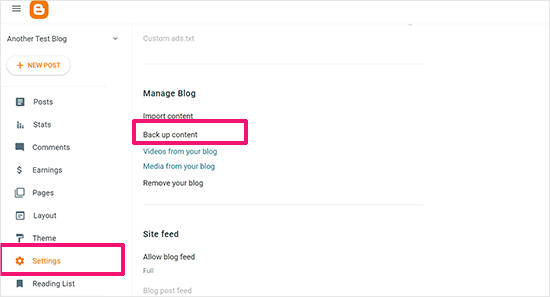
Daraufhin erscheint ein Popup-Fenster, in dem angezeigt wird, was genau in der Blogger-Sicherung enthalten ist.
Um fortzufahren, müssen Sie auf die Schaltfläche “Herunterladen” klicken.

Der Inhalt Ihres Blogger-Blogs wird in einer XML-Datei auf Ihren Computer heruntergeladen.
Sobald der Download abgeschlossen ist, können Sie Ihre Blogger-Inhalte in Ihre WordPress-Website importieren.
Schritt 2: Blogger in WordPress importieren
Um mit dem Import Ihrer Blogger-Site in WordPress zu beginnen, melden Sie sich in Ihrem WordPress-Administrationsbereich an und besuchen Sie Tools ” Importieren.
Klicken Sie auf der Import-Seite auf den Link “Jetzt installieren” unter Blogger.

WordPress wird nun das Blogger-Importer-Plugin für Sie herunterladen und installieren.
Sobald die Installation abgeschlossen ist, müssen Sie auf den Link “Importer ausführen” klicken, um fortzufahren.

WordPress wird Sie auf dem Bildschirm Blogger importieren auffordern, die XML-Datei hochzuladen. Dies ist die Datei, die Sie in Schritt 1 heruntergeladen haben.
Klicken Sie einfach auf die Schaltfläche “Datei auswählen” und laden Sie die XML-Datei hoch, die Sie zuvor heruntergeladen haben.
Klicken Sie anschließend auf die Schaltfläche “Datei hochladen und importieren”, um fortzufahren.
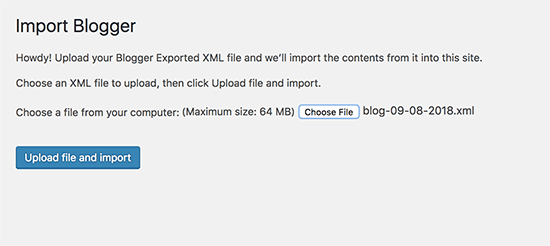
WordPress wird nun die Importdatei hochladen. Wenn Ihre Importdatei zu groß ist, wird möglicherweise eine Fehlermeldung angezeigt.
In diesem Fall müssen Sie die Höchstgrenze für den Datei-Upload erhöhen. Wenn Ihre Datei klein ist, werden Sie keine Fehler sehen.
Als Nächstes werden Sie aufgefordert, Beiträge einem Autor zuzuweisen. Wenn Sie mehrere Autoren in Ihrem Blogger-Blog haben, können Sie für jeden Autor ein neues Benutzerkonto erstellen. Sie können diese Beiträge auch bestehenden Autoren auf Ihrer WordPress-Website zuweisen.

Nachdem Sie Ihre Auswahl getroffen haben, klicken Sie auf die Schaltfläche “Senden”, um fortzufahren.
WordPress importiert alle Inhalte aus der Blogger-Exportdatei in Ihre WordPress-Website. Sie können den Inhalt auf der Seite Beiträge ” Alle Beiträge einsehen.

Schritt 3: Permalinks einrichten
Permalinks ist der Begriff für die URL-Struktur der einzelnen Seiten. WordPress verfügt über eine Funktion, mit der Sie eine SEO-freundliche URL-Struktur einrichten können.
Da Sie Inhalte von Blogger importieren, muss Ihre URL-Struktur der URL-Struktur Ihrer alten Blogger-Site so nahe wie möglich kommen.
Um Permalinks zu setzen, müssen Sie in Ihrem WordPress-Dashboard zu Einstellungen ” Permalinks gehen und die Option “Benutzerdefinierte Struktur” wählen.
Danach müssen Sie den folgenden Text in das Feld neben dem Feld für die benutzerdefinierte Struktur eingeben:
1 | /%year%/%monthnum%/%postname%.html |
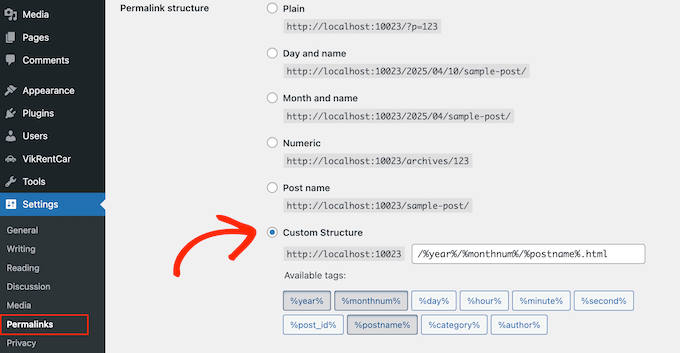
Mit dieser Permalink-Struktur ähneln die URLs Ihrer Blogposts den URLs in Ihrem alten Blogger-Blog.
Es kann jedoch vorkommen, dass die URL Ihres Blogeintrags, in WordPress auch als Slug bezeichnet, nicht mit den von Blogger verwendeten Slugs übereinstimmt.
Um dies zu beheben, müssen Sie ein kleines Codeschnipsel erstellen und ausführen.
Wir empfehlen, diesen PHP-Code mit dem WPCode-Plugin hinzuzufügen. Das ist der sicherste Weg, um benutzerdefinierten Code zu Ihrer WordPress-Website hinzuzufügen. Weitere Einzelheiten finden Sie in unserer Anleitung zum Kopieren und Einfügen von Codefragmenten in WordPress.
1 2 3 4 5 6 7 8 9 10 11 12 13 14 | add_action( 'init', 'wpb_update_slug' );function wpb_update_slug() {global $wpdb;$result = $wpdb->get_results("SELECT post_id, meta_value FROM $wpdb->postmeta WHERE meta_key = 'blogger_permalink' ");$wpdb->print_error();foreach ($result as $row){$slug = explode("/",$row->meta_value);$slug = explode(".",$slug[3]);$wpdb->query("UPDATE $wpdb->posts SET post_name ='$slug[0]' WHERE ID = '$row->post_id' ");}echo "DONE";} |
Nachdem Sie den Code gespeichert haben, brauchen Sie nur eine beliebige Seite auf Ihrer WordPress Website zu besuchen, um dieses Skript auszulösen. Vergessen Sie nach der Ausführung des Skripts nicht, es zu deaktivieren oder aus Ihrer WPCode-Bibliothek zu löschen, da es nur einmal ausgeführt werden muss.
Schritt 4: Umleitungen von Blogger zu WordPress einrichten
Der wichtigste Schritt beim Umzug einer Website ist die Einrichtung einer korrekten Umleitung, damit Sie keinen bestehenden Traffic oder SEO-Rankings verlieren. Weitere Details finden Sie in unserer ultimativen WordPress SEO-Migrations-Checkliste.
⚠️ Wenn Ihr Blogger-Blog eine eigene individuelle Domain anstelle von blogspot.com hat, müssen Sie Ihre Domain-Nameserver möglicherweise auf Ihren Hosting-Anbieter verweisen. Für Anweisungen folgen Sie bitte unserer Anleitung, wie Sie eine individuelle Domain von Blogger zu WordPress wechseln.
Entscheidend bei der Weiterleitung ist, dass Ihre Nutzer auf der neuen Domain auf der gleichen Seite landen, die sie auf der alten Site aufgerufen haben.
Gleichzeitig müssen Sie dafür sorgen, dass die Suchmaschinen verstehen, dass Ihre Website an diesen neuen Ort verlegt wurde.
Dazu müssen Sie das Plugin für die Umleitung von Blogger zu WordPress installieren und aktivieren. Weitere Details finden Sie in unserer Schritt-für-Schritt-Anleitung zur Installation eines WordPress-Plugins.
Nach der Aktivierung müssen Sie die Seite Tools ” Blogger to WordPress Redirection besuchen und auf die Schaltfläche “Start Configuration” klicken.
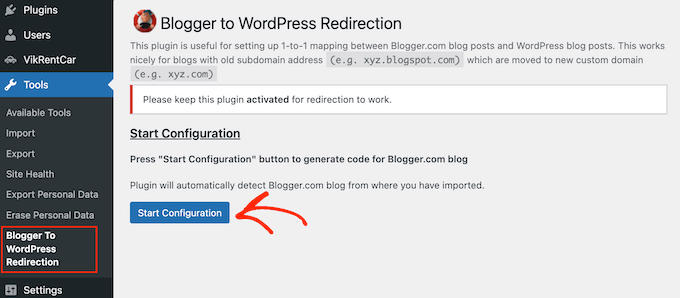
Das Plugin erkennt nun die URL Ihres Blogger-Blogs und zeigt Ihnen die Option an, einen Umleitungscode zu erhalten. Klicken Sie auf die Schaltfläche “Code abrufen” neben Ihrer Blogger-URL.
Es wird nun ein Codeschnipsel generiert, den Sie benötigen, um Benutzer von Ihrem alten Blogger-Blog auf Ihre neue WordPress-Website umzuleiten.
Als Nächstes müssen Sie sich in Ihrem Blogger-Dashboard anmelden und die Seite “Themen” aufrufen. Klicken Sie auf den Dropdown-Pfeil auf der Schaltfläche “Anpassen” neben Ihrem Thema, und wählen Sie dann die Option “HTML bearbeiten”.
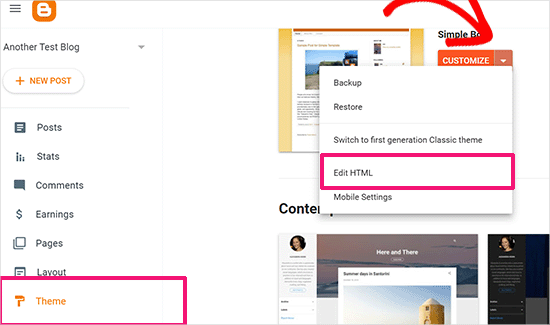
Blogger zeigt nun den benutzerdefinierten HTML-Code für Ihre Themenvorlage an. Wenn Sie Anpassungen an Ihrem Blogger-Theme vorgenommen haben, sollten Sie den Code kopieren und auf Ihrem Computer als Backup speichern.
Andernfalls können Sie einfach alles löschen. Kopieren Sie anschließend den vom Plugin angezeigten Code auf Ihrer WordPress-Website und fügen Sie ihn in den Editor Ihres Blogger-Themas ein.
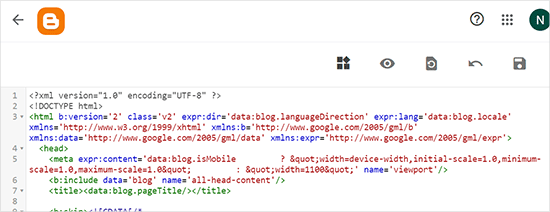
Vergessen Sie nicht, auf die Schaltfläche “Thema speichern” zu klicken, um Ihre Änderungen zu speichern.
Als Nächstes müssen wir Umleitungen für mobile Benutzer einrichten.
Gehen Sie im Dashboard Ihres Blogger-Blogs zurück zur Seite “Themen”. Diesmal müssen Sie auf die Zahnrad-Schaltfläche unterhalb der mobilen Vorschau Ihres Blogs klicken.

Daraufhin wird ein Popup-Fenster angezeigt, in dem Sie die Option “Nein. Desktop-Thema auf mobilen Geräten anzeigen” auswählen müssen.
Klicken Sie dann auf die Schaltfläche “Speichern”.
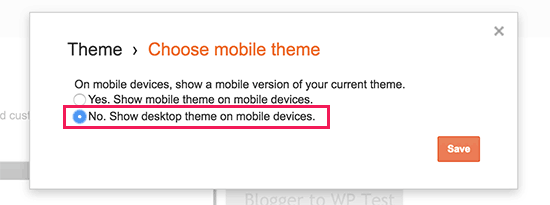
Das war’s. Ihr Blogger-Blog leitet nun alle Besucher Ihres Blogs auf Ihr neues WordPress-Blog um.
Alternativ können Sie auch All in One SEO (AIOSEO) verwenden, um Beiträge und Seiten von Blogger zu WordPress umzuleiten. Das Plugin bietet eine leistungsstarke Funktion für den Weiterleitungsmanager, mit der Sie vollständige Weiterleitungen zu Ihrer neuen Website einrichten können.

Außerdem können Sie die Verfolgung von 404-Fehlern aktivieren und alle defekten Links aufspüren, die bei der Umstellung Ihrer Website auf WordPress auftreten können. Dadurch wird die Benutzerfreundlichkeit verbessert, und Sie verlieren keine Keyword-Rankings.
Wir nutzen AIOSEO, um alle unsere WPBeginner Seiten und Beiträge zu verwalten – und ganz ehrlich? Wir sind von den Ergebnissen überwältigt. Deshalb ist es unsere beste Empfehlung für Sie alle.
Wenn Sie mehr über unsere Erfahrungen erfahren möchten, lesen Sie unsere ausführliche Rezension über AIOSEO.
Schritt 5: Verschieben anderer Inhalte von Blogger zu WordPress
In diesem Schritt werden wir die restlichen Inhalte aus dem alten Blog auf Blogger in Ihren neuen WordPress-Blog verschieben. Dies kann je nach den Einstellungen/Inhalten Ihres Blogs etwas manuelle Arbeit erfordern.
1. Verschieben von Seiten von Blogger zu WordPress
Das Blogger-Import-Tool von WordPress importiert nur Blogger-Beiträge und ignoriert Seiten.
Um Ihre Seiten in WordPress zu übertragen, müssen Sie jede Seite in Ihrem Blogger-Blog bearbeiten, ihren Inhalt kopieren und dann manuell eine Seite in WordPress erstellen.
Um mehr über Seiten zu erfahren, lesen Sie unseren Artikel über den Unterschied zwischen Posts und Seiten in WordPress.
Nun werden Sie auf ein weiteres Problem stoßen. Die Blogger-Seiten haben URLs, die wie folgt aussehen:
http://example.blogspot.com/p/about-us.html
Die URL Ihrer WordPress-Seite sieht dann so aus:
http://example.com/about-us
Um dies zu beheben, müssen Sie das All in One SEO (AIOSEO) Plugin verwenden. Eine Anleitung dazu finden Sie in unserem Leitfaden für Einsteiger zum Erstellen von Weiterleitungen in WordPress.
2. Widgets
Wie Blogger verwenden auch einige WordPress-Themes Widgets, um Inhalte in die Seitenleiste Ihres Blogs einzufügen.
Um Widgets hinzuzufügen, müssen Sie die Seite Erscheinungsbild ” Widgets in Ihrem WordPress-Dashboard aufrufen und Widgets einfach per Drag & Drop in die Seitenleisten ziehen. Ausführliche Anweisungen finden Sie in unserem Leitfaden zum Hinzufügen und Verwenden von Widgets in WordPress.
Wenn Sie ein bestimmtes Widget suchen, das nicht standardmäßig in WordPress enthalten ist, dann benötigen Sie wahrscheinlich ein WordPress-Plugin. Sie können WPBeginners beste WordPress-Plugin-Kategorie durchsuchen, um die gewünschte Funktionalität zu finden.
3. RSS-Feeds
Suchmaschinen und Nutzer, die Ihre Blog-Beiträge über RSS-Feeds abonnieren, können Ihr Blog weiterhin finden. Sie werden jedoch keine neuen Inhalte erhalten.
Um dies zu beheben, besuchen Sie die Seite Einstellungen in Ihrem Blogger-Konto. Scrollen Sie dann nach unten zum Abschnitt “Site-Feed” und klicken Sie auf “Post-Feed-Redirect-URL”.

Daraufhin wird ein Popup-Fenster angezeigt, in das Sie die URL des RSS-Feeds Ihrer WordPress-Website eingeben müssen.
Die URL Ihres WordPress-Feeds sieht dann so aus:
http://example.com/feed
Vergessen Sie nicht, example.com durch Ihren eigenen Domänennamen zu ersetzen.
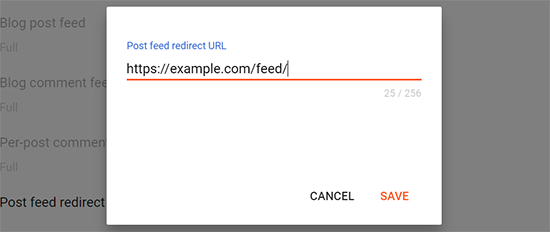
Klicken Sie auf die Schaltfläche “Speichern”, um die URL hinzuzufügen und Ihre Einstellungen zu speichern.
Schritt 6. Was Sie nach der Migration von Blogger zu WordPress tun sollten
Nachdem Sie Ihren Blogger-Blog nun erfolgreich nach WordPress verschoben haben, wollen wir uns ansehen, was Sie noch tun können, um Ihren Blog zu verbessern.
Wir haben eine Checkliste mit den wichtigsten Dingen erstellt, die Sie nach der Installation von WordPress erledigen müssen.
WordPress ist recht einfach zu bedienen. Dennoch werden Sie gelegentlich neue Dinge entdecken, bei denen Sie vielleicht Hilfe benötigen. An dieser Stelle kommt WPBeginner ins Spiel.
WPBeginner ist die größte kostenlose WordPress-Ressourcen-Website der Welt. Wir veröffentlichen regelmäßig Tutorials und Anleitungen, die speziell für Blogger und kleine Unternehmen geschrieben wurden.
Hier sind einige der nützlichen Ressourcen, die Sie auf WPBeginner finden werden (alle sind kostenlos):
- WPBeginner Blog – Der zentrale Ort für alle unsere WordPress-Tutorials und -Anleitungen.
- WPBeginner Dictionary – Unser WordPress-Glossar ist der beste Ort, um sich mit dem WordPress-Jargon vertraut zu machen
- WPBeginner Videos – Neue WordPress-Nutzer können mit diesen Schritt-für-Schritt-Videos beginnen, WordPress zu beherrschen.
- WPBeginner auf YouTube – Brauchen Sie mehr Videoanleitungen? Abonnieren Sie unseren YouTube-Kanal mit mehr als 291.000 Abonnenten und über 50 Millionen Aufrufen.
- WPBeginner Blueprint – Sehen Sie sich die Plugins, Tools und Dienstleistungen an, die wir auf WPBeginner verwenden.
- WPBeginner Deals – Exklusive Rabatte auf WordPress Produkte und Dienstleistungen für WPBeginner Nutzer.
Video-Anleitung
Wir hoffen, dass dieser Artikel Ihnen geholfen hat, von Blogger zu WordPress zu wechseln, ohne Ihre Google-Suchergebnisse zu beeinträchtigen. Vielleicht interessiert Sie auch unser Leitfaden, welchen WordPress-Plan Sie verwenden sollten, oder die häufigsten WordPress-Mythen, die entlarvt wurden.
Wenn Ihnen dieser Artikel gefallen hat, dann abonnieren Sie bitte unseren YouTube-Kanal für WordPress-Videotutorials. Sie können uns auch auf Twitter und Facebook finden.





Marco Dickert
Hi there,
I just tried to migrate my blogger-blog to my self-hosted wordpress. Almost all things work as expected, but not the redirection from blogger. I inserted a logging function in the template code for the wordpress-sided interface and recognized that this page does not get any parameters from the blogger redirection. That means I simply get redirected to my home page.
Is it possible that blogger changed variable names or something? Does anyone has an idea how I could fix that problem?
Cheers, Marco
WPBeginner Support
Marco, we have just updated the post with a completely new re-written version. Please follow it now, hopefully it will resolve your issue.
Admin
Marco Dickert
@WPBEGINNER Support:
First of all: It’s really nice that you’ve updated this article! I guess you help many users with that.
Meanwhile I solved my problem, and wrote my solution in an email to Amit Agarwal, but he seems to be very busy.
Since I come from Germany I don’t get “blogspot.com”-Domains in my Google search results, but “blogspot.de”. Others in German-speaking Europe get also different TLDs like “blogspot.at” or “blogspot.ch”. That is a problem for the template code. I could fix that simply by changing these lines:
$tld_fix = preg_replace("/blogspot\.[a-zA-Z0-9]+/", "blogspot.com", $old_url);$permalink = explode("blogspot.com", $tld_fix);With this fix it should work all around the world. Maybe you can implement it in your post; it might be useful for some people.
Cheers, Marco
WPBeginner Support
Thanks Marco for this really useful fix. We have updated the article to include this.
nil
Hey,
I have the same problem. Tried your script but when I go to an old posting I just get redirected to my first page, not to the post.
Regards
nil
Liza Pritz
Wouldn’t it be easier to use a plugin? Something like “CMS2CMS Blogger to WordPress Converter” ? With this plugin, it is posible to migreta the content, the set up 301 redirect and keep all the visitors and ranking on a new WordPress site?
Does anyone knows something about that?
Saad Ansari
Nice efforts. One shop stop guide for Blogger to WordPress migration.
Is there any way of importing all images from blogger and put them all together in WordPress? I’ve a huge number of images with me. Uploading each of them MANUALLY would be a nightmare, isn’t it? So do let me know if there is any smart and efficient plan B for it. Thanks!
Xuhair Raxa
great post !!! but i have a question.. that is after the conversion,will the domain be .com or blogspot.com ? As i have a blog http://tricksnsolutions.com which is wp blog after making it a blogger blog shall it remain to tricksnsolutions.com or tricksnsolutions.blogspot.com ? please solve my confusion
WPBeginner Support
This guide is for switching from Blogger to WordPress not the other way around.
Admin
Briana M
My old website is with Blogger, but I am switching over to WordPress and using a new domain name. I already have hundreds of business cards with my old domain name listed (###.blogspot.com) and I want that old domain name through Blogger to redirect to my new domain name and WordPress website. How can I go about doing this?
WPBeginner Support
You can do so following the steps mentioned in the article above.
Admin
Kanchana
thanks ,,,
Bryan
Hi there,
I am a newbie.
I just wanted to ask a quick question:
When I import my blogger posts into wordpress, will they be deleted from blogger or will they still be there with no changes?
Thanks
WPBeginner Support
They will still be there if you don’t explicitly delete them.
Admin
Christian
Hi!
The Blogger code doesn’t work today. I think the markup is obsolete because Blogger says the following by submitting the code from WP Beginner:
“The value of attribute “dir” associated with an element type “html” must not contain the ‘<' character."
I just replaced simple and double quotes and other ways to solve this, but is completely impossible. Does anyone know if Blogger has made related to the markup?
Thank you all.
hafzaa
Very well explained…will try it..hope so it may work…
Kapil Dev Singh
I have moved from blogger to WordPress and carried out all the steps. I am encountering two problems-
1. The blogger link for specific blogs is not taking me to the wordpress
2. When someone wants to come to wordpress following a specific blog link, it shows – the file could not be found and give a list of all the published blogs. Once clicked on the specific blog for which the link was followed, it opens up.
Regards
Desi
I keep getting this message in blogger
Error parsing XML, line 2, column 73: The value of attribute “dir” associated with an element type “html” must not contain the ‘<' character.
anyone else?
Carl
(Previous comment did not include code… how can I do that?)
Not sure if something has fundamentally changed with the blogger importer or how posts info is stored in the database; But the code above for the wpbeginner-blogger.php failed for almost all my links. I ended up changing it to this:
<?php/*Template Name: Blogger Redirect (do not use)*/global $wpdb;$old_url = $_GET['q'];if ($old_url != "") {$permalink = explode("blogspot.com.au", $old_url);$new_url = $permalink[1];header ("HTTP/1.1 301 Moved Permanently");header("Location: $new_url");}?>Anyone see any reason this is bad? It seems to work perfectly, I’m still trying to figure out why it was done any other way to begin with… As long as you fix the permalinks to match the old blogger ones
Dean
Hi, hopefully someone will be able to help. Whenever I click one of my old blogger posts it just sends me to my new wordpress site’s homepage not to the correct blog post? any ideas how to fix this. thanks.
Raj Amal
My old blogger posts it just sends me to my new wordpress site’s homepage not to the correct blog post. Plese help me
Paige
I’m having the same issues. How did you fix this?
Sanskar
I am stuck with the infinite loop. The website keeps refreshing and never loads. I am not sure how to fix it.
Sanskar
OK, I am sorry about the previous comment. I was using Switch hosts firefox plugin and I was browsing on my local copy. My website has not gone live yet. Though I have clicked on Go live button on Godaddy, and looks like DNS settings are updated, but my website has gone in an infinite loop and never loads. It loads the title, loads the favicon and I also see it loading chrome extensions like alexa and adblock, but then it refreshes and starts loading again. This never stops.
Do you think it is the problem with DNS? or that I did not follow the tutorial properly? It has been already 11 hours since I updated the DNS. Both my domain and hosting is bought from Godaddy.
WPBeginner Support
Using an FTP client, connect to your website and download .htaccess file to your computer. Then delete the one on your live site. See if this resolves the issue. If it does, then this means there is nothing wrong with DNS settings of your website and it was probably a redirection issue. You may also contact your web host for support if this does not solve your issue.
Admin
Gari Anne
Everything worked perfectly! Thanks! How Long do I have to leave the Published “Blogger” page on my new word press blog? Or is there a way to hide that page?
Carol
I’m still having the same problems but none of my comments have been published or answered. Did the guy who wrote this post give up on it? I’ve noticed a few people had the same problem – is it something that can be fixed? It would be great to get a response.
Thanks
carol
ok – I’ve been reuploading the text doc over and over and one thing that has changed is – I’m using a Mac and my doc is .rtf. When I take the .rtf off after the .php I get the line 16 error code but if I keep the.rtf on after the .php and I clink on any of my blogger posts it redirects to the Blogger page that I created for the redirect on my new website. Does that make sense? I don’t understand any of this php stuff so I don’t have any idea why it would do that just by adding or deleting the .rtf extension – but that’s what happens.
I hope you have some idea of how I can fix this. It seems like it’s something pretty simple – I just don’t know what.
carol
i just redid all the the cpanel installation part and now the syntax error says line 16
Parse error: syntax error, unexpected T_STRING in /home4/craftyc/public_html/wp-content/themes/suffusion/wpbeginner-blogger.php on line 16
carol
I just went through the whole process and when I click on “View Blog” on my Blogger page it redirects perfectly to my website (yay!), but if I click on any of the individual posts I get this error message:
Parse error: syntax error, unexpected T_STRING in /home4/craftyc/public_html/wp-content/themes/suffusion/wpbeginner-blogger.php on line 15
I saw some people here getting syntax errors on different lines but I didn’t see anything to fix it.
Besplatne Knjige
Hello!
I have this blogger blog, and I would like to build some backlinks on worpress blog. Is there any way to create some wordpress blog and automatically post parts of my original post from blogger with my link. Something like auto post on social networks…
I hope you understand what I want (my English is not so good)
Thank you
nick
hi, i am about to carry out this process but i have one concern. my blogger address doesnt have the blogspot.com attached to it. i paid to have the domain showing just my blog name. however i still edit my blog with blogger. now i want to switch and im wondering if theres any step i need to do differently so as not to run into problems.
cheers
Sharon
I have the same situation. I already bought my domain but still hosting it on blogger and I want to switch but I don’t know if I should follow the same steps as discussed here on this post. Any help is greatly appreciated.
Jackie Montalvo
I have the same issue so I’d love to hear what my options are because I’ve wanted to switch ove but I wasn’t sure I could since I bought the domain name already. Please let me know!
WPBeginner Support
You can manage your custom domain from the registrar website. Currently Blogger has stopped offering custom domain registration from the Blogger interface so most users need to purchase a domain from another registrar and then setup the domain to point to the Google servers. When moving this domain to a new web host you need to remove these settings from your domain control panel on the registrar’s website.
1. First find out your domain registrar.
2. Login to your domain registrar control panel.
3. Remove CNAME and A record settings pointing to Google servers.
4. Enter your new webhost’s settings into domain control panel.
Most WordPress hosting providers offer detailed guides on how to move a domain name to point to their servers.
Admin
Holt Johnson
I found the Blogger To WordPress plugin to be much simpler to use.
http://wordpress.org/plugins/blogger-to-wordpress-redirection/
Amanda
Thank you SO much for posting that plugin …. I was going crazy trying different tutorials with none of them working!
Naomi Madelin
I tried this, but get the message from WordPress that I can’t access Content nor fiddle with Themes in any way. So I’m now stuck!
Sagar
Hello!
I want to migrate a blog on Blogger to WordPress which just has 15 pages, no posts, so I can do it manually, but I want to know about 301 redirect, how do I do it? Please can you help me with this?
Elaine Griffin
I’m very confused, because when I go to tools -> import, I am prompted to download a plugin. Any thoughts?
Thanks!
Editorial Staff
Yes you have to do that.
Admin
Emma
Does anyone know if you can import from 2 different blogger blogs into one wp?
Jan Bear
Thanks for a useful post.
When you’ve finished this process, will you be able to do future blog posts in WordPress, or do you have to continue using Blogger as your blog platform?
Does this integrate the WordPress and Blogger blog posts? Or will they be on separate pages of the new site?
Editorial Staff
You would have to use WordPress for all new posts.
Admin
Wendi Gratz
Never mind – I figured it out. For those who run into the same problem. . .
When you copy and paste the PHP coding make sure there isn’t a blank line above the start of the <?php.
I don't know if mine snuck in during copying or pasting – but I removed it and everything works perfectly now.
Lenin
For some users, all the blogspot posts might be redirected to the new blog homepage (and not the individual new post URL). This is because the original link is blogspot.in and not blogspot.com
To fix this issue, add the following line of code after the link $permalink = explode(“blogspot.com”, $old_url);
if(count($permalink) == 1) //we cant find blogspot.com in the URL lets try for blogspot.in
{
$permalink = explode(“blogspot.in”, $old_url);
}
Tim
Great post. Unfortunately after doing this Google marked my old Blogger blog as a spam blog! I’m going through the process to get it unlocked, so hopefully that will solve it. Great tutorial though and very simple to follow – thanks!
John Pile
This is a really great step-by-step tutorial. Unfortunately, I missed one of the wpbeginner.com links in the replacement template for my blogger site. It resulted in redirecting to your website, which then prompted Blogger to immediately mark my blog as SPAM.
I fixed the template and now everything redirects correctly, but I had to request that my blog be reviewed or else it will be deleted in 22 days.
I’m wondering if anyone else has ran into this issue and how the review process went? I used one of my test websites for this, so I won’t be incredibly disappointed if the original blogger site is deleted, but I did want to offer this warning to others. I recommend using CTRL-F to replace all occurrences of wpbeginner.com in the template.
-John
Tim
I replaced all instances and it still marked my old blog as spam. It must just be the fact that it’s doing a complete redirect that makes them think it could be spam. I’ve just kicked off the review process, so I’ll have to see how it goes. Did yours come back ok in the end?
R. endymion
Hello, I’ve also replaced all instances but it is still marked as SPAM. Has anybody found a solution for this ?
Thank you.
R. endymion
I report to google and they change it in only one day. We just need to be patient.
jose morales
I just downloaded all my site in Blogger however it is not showing the whole article… any ideas?
Salue
i’v done all of this THANK YOU
was wondering 1 thing can i delete the blogger page that i made ? because its showing in the menu bar like next to about me
zed kosnar
Hello again! managed to fix the other error, and now i get redirected from Blogger to wordpress, but if I click on an old post, of blogger I get his message “Parse error: syntax error, unexpected T_LNUMBER in /nfs/c09/h01/mnt/127155/domains/desdeabajo.net/html/wp-content/themes/twentyeleven/WPBeginner-Blogger.php on line 5” hope you can guide me here… Thanx in advance!
zed kosnar
Hello!
I followed the instructions but when I posted the HTML (step 5) try to check “a preview” I get this message “Your template could not be parsed as it is not well-formed. Please make sure all XML elements are closed properly. XML error message: Comment must start with “<!–".
Error 500 " I double checked data and still getting this message, doesn't save if I click try to go ahead… Any thoughts what I could be doing wrong? Thank you!
David
Hi, on step 5 I get this message:
Error parsing XML, line 3, column 73: The value of attribute “dir” associated with an element type “null” must not contain the ‘<' character.
Can you help?
nick
solve this issue? im experiencing the same error
Alexander
The problem occurs if you do not press “Revert to classic template”. Even if you did not changed the template at the beginning you have to revert to classic template, then it should work.
Joanna Mecina
Hello, i have a blogger template, how ca i convert it to wordpress? Thanks
Linda Leyble
Hi – very good post. I switched last month from Blogger and I am very happy. But, since Feedburner is going away – do you recommend that we use FeedBlitz instead? Very confused about this.
And also – when I left Blogger – I lost many of my followers on GoogleFriend Connect. I emailed my followers there and alerted them to my new site. Slowly but surely I am gaining them back on my new site. I also emailed the RSS followers on Feedburner and also on Bloglovin. Do you recommend any other ways for people to follow your blog?
Thanks,
Linda
Editorial Staff
We haven’t seen any public press release by Google that says FeedBurner is going away. Sure there are some speculations around the industry that it is, but only time will tell. We are sticking with feedburner for now.
Admin
Kaitlin
Everything looked great, but now that I’m clicking past links (posted to facebook) to check if the redirect is working properly, I’m getting this error:
Parse error: syntax error, unexpected T_STRING in /home/content/81/9774981/html/wp-content/themes/simple-catch/WPBeginner-Blogger.php on line 3
Help?
Editorial Staff
Line 3 is the name of the template. There has to be another error.
Admin
Jeanne
I just migrated a blog from blogger to WordPress but used a plugin to perform a similar task as above. I don’t like plugins and am thinking of deactivating it and doing this instead.
Question though: One thing I found that did NOT work when I did this was that pages did not redirect. Posts redirected just fine with no problems at all (well, I did have to have my hosting provider whitelist mod security) but PAGES would not redirect at all (and, worse, not only would they not redirect, links pointing to old blogger pages would return a “page not found” error).
Before I deactivate the plugin I’m using, and go this route, I’m curious if this will work for pages….Any comment?
Thanks!!
Gretchen Louise
I’m not seeing the “Revert to Classic Template” anywhere. Have they removed that option?
Dave Morrow
Agreed, I am having the same problem, the newest Blogger does not seem to have that option… Anyone else have an answer for this?
Tom G
Go to templates…
Scroll to the bottom of the page.
It says something like “Classic Template” or something like that. I can;t get to it now that I have done it.
Then scroll to the bottom of that refreshed page. It’s at the bottom.
Sorry if this doesn’t make sense. It was not as cut and dry as listed above.
Chetan
Nice Post. I was wondering if moving from blogspot to wordpress is possible if I have a custom domain hosted on blogger?
Look forward to your reply.
Monkey
Hi, Great tutorial thank you.
Does this work with any wordpress theme?
I am very new to WordPress. So apologies if this is an ignorant question.
Editorial Staff
Yes this should work with any WordPress theme.
Admin
Ahmad Awais
Nice tutorial Faizan Bro, Finally you are using WordPress
I hope you are not quite aware of the fact that WP is much strong than Blogger platform.
Keep up your great work.
–
I would rather say that instead of page template you can slowly move on to each post and use 301 redirect plugin for redirecting and making your blog independent of the old blogger’s template.
Syed Faizan Ali
Thanks Bro, Yeah After going through lots of Articles and Tutorials I discovered WordPress is the best Blogging Platform I have converted few of my Blogger Blog to The Self-Hosted WordPress Blog.
Your Idea is Cool but if we have tons of Posts like 4000 posts, then redirecting would become stressful. This method is quite good, takes less time and gives perfect results.
Derek
Hi Stephen,
For step 4 how do you write “blogger” in the URL? Click on change permalinks? I did that and change the permalink to end with /blogger but still revert back to previous URL that end with ?page_id=149.
Syed Faizan Ali
Brother Create a New Page and Write The Title blogger, Choose WPbeginner from the Template Menu don’t Worry About the URL And Publish it, Now Open the Published Page Again From Your WordPress ADMIN PANEL and you will be able to See the URL beneath the Page Title, Just Click EDIT and rename it to /blogger and don’t Forget to UPDATE THE POST.
Also Update your WordPress Permalink Go to WordPress Dashboard >> Settings >> Permalinks >> Custom Structure >> /%year%/%monthnum%/%postname%.html.
Gautam Doddamani
i was using blogger earlier but changed to wordpress since it is the best cms around and also i get full control over my site…and there are a ton of tutorials for wordpress which makes blogging more easier and fixing site less time consuming
Syed Faizan Ali
Yes, indeed WordPress has the most powerful Blogging Platform. Keep it up on Good Things Peace and Blessing.
Guppu Boss
Nice Tutorial Faizan. I have just purchased hosting and after my exams i am going to transfer my blogger blog to wordpress. You explained all steps very well. Will follow this tutorial again while transfering my blog.
Syed Faizan Ali
Thanks For Sharing Nice Views, Yes Brother Feel Free To Apply This Tutorial Any Time You Like. Its Great That you are thinking to move from Blogger to WordPress, it will give more power to you. Peace Mate
Mairaj Pirzada
Great Post, well done Syed Brother! You did a Nice Work! Keep it up but I don’t need this post as My site is now setup on WordPress!
Syed Faizan Ali
Oh it’s Splendid, that you are already using WordPress. Thanks Buddy. Peace and Blessings
Stephen Cronin
Hi. Have you tested that PageRank is preserved?
The 301 is happening on your WordPress site, not your Blogger site. It is merely telling Google to use one of your WordPress pages instead of another one of your WordPress pages (and transfer PageRank between these).
The 301 is not telling Google to use your WordPress site instead of your Blogger site, or to transfer any PageRank from your Blogger site to your WordPress one.
You’re using JavaScript to move *users* from the Blogger site to the WordPress one, but there is no evidence that Google will treat this as a 301 and transfer any pagerank.
A few years ago, the prevailing SEO wisdom would have been that Google couldn’t even crawl the JavaScript, so the Googlebot wouldn’t even go to the WordPress site. Googlebot can now execute some JavaScript, but still – what makes you think it will treat it as a 301?
I’m not having a go at you personally, but this is the first I’ve heard of this (I can’t find anyone else in SEO circlet talking about this) and I’d be really interested in seeing the evidence that this works. Thanks.
Editorial Staff
Hey Stephen,
This is a guest post. However from the looks of the code, the canonical tags are the ones that should do the work.
Admin
Stephen Cronin
Okay, I missed that. That will probably work as well as anything. #mybad.